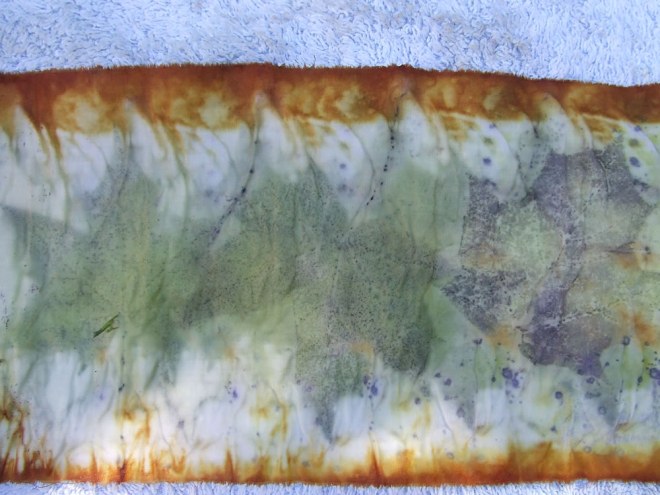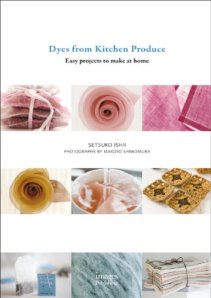Feast or famine: I haven’t posted for a while, so today you’re getting a long photo-heavy post! All the garments featured are upcycled, bought from charity shops or auctions.
With most of the previous ecoprinting I’ve done I have not mordanted the fabric. I’ve used mostly silk and wool, which are protein fibres and tend to print OK if I bundle them with a piece of cloth soaked in iron. The vintage cream silk dress below, for example, was not mordanted in advance – I just used maple leaves and an iron “blanket”.
So I extended this method to other silk garments that were already dyed different colours. The scarf below was a strong lime yellow, and I printed it with different geranium (cranesbill) leaves. I picked the leaves from the garden of lovely embroiderer Lucy Goffin, who makes beautiful bespoke structured garments and also runs the fantastic Marchants nursery with her husband Graham.
This is an orange silk skirt printed with maple leaves. The orange was quite dark, so the print is quite subtle.
And this was a pale pink silk blouse printed with larger maple leaves.
Just as experiment, I also printed an unmordanted yellow cotton T-shirt with sycamore leaves. As well as the shape of the leaves, I love the shapes produced by the long stalks – so you will see quite a few sycamores featuring below!
I then mordanted a batch of garments with alum, and dyed them with natural dyes before ecoprinting on top.
This is a cotton apron dyed with oak leaves and printed with sycamore leaves.
This T-shirt was dyed in the oak leaves after the apron, so it was a paler brown, before printing with maple leaves. The maple leaves were quite thick and waxy, so they seem to have acted more like resists than printing themselves. You can also see very clearly the effect of using an iron blanket, as I mistakenly forgot to include it in one part of the bundle! I may have to overprint this with something else.
Finally, it was back to silk. Here’s a silk top dyed with onion skins and printed with sycamore leaves.
Another silk top dyed with pomegranate and printed with sycamore leaves. Both the onion skins and the pomegranate gave very similar golden yellows after dyeing (sorry – forgot to take any photos), but I simmered the pomegranate bundle with the sycamore leaves for less time, so it’s brighter.
The cotton apron picked up more details from the leaves than the cotton T-shirts, and the silk was even better, perhaps due to the relative thickness of the fabric?So many combinations and permutations to try!
























































